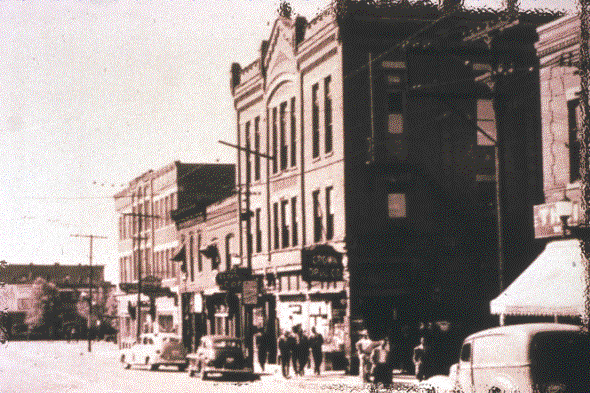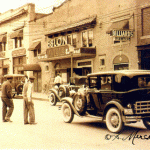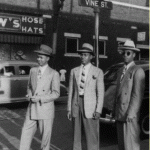 The 18th and Vine Historic District is the African-American cultural district in Kansas City. It earned the name, “Jazz District” during the period from 1920 to 1940 when it became the center of jazz music. People could attend performances by jazz greats such as Count Basie, Ella Fitzgerald, Louie Armstrong and others.
The 18th and Vine Historic District is the African-American cultural district in Kansas City. It earned the name, “Jazz District” during the period from 1920 to 1940 when it became the center of jazz music. People could attend performances by jazz greats such as Count Basie, Ella Fitzgerald, Louie Armstrong and others.
The neighborhood was important to the evolution of jazz, a truly American art form. The heart of the District is about two miles southeast of downtown Kansas City. A significant goal of the revitalization effort is to add a strong entertainment component to the neighborhood mix.
Kansas City’s 18th & Vine neighborhood was developed during the era of segregation after an influx of individuals migrated to Kansas City seeking better jobs and a new way of life. Making their homes and businesses in two and three story brick buildings along the districts cross streets (18th & Vine) and by the end of the 19th century this small community had flourished into a thriving African-American neighborhood.
By the turn of the twentieth century, 18th & Vine had become a city within a city. African-Americans needed to go no further to find all the necessities for day-to-day living. In addition to retail businesses, 18th & Vine became a popular office address for the community’s growing number of black professionals. Schools, entertainment venues, social clubs, churches and recreational facilities rounded out the activities in the neighborhood.
Early in the 20th century, jazz music developed in the black communities of the nation’s urban cores. As Kansas City Jazz came into its own in the 1920s, its sound could be heard emanating around the clock from the dance halls and nightclubs near 18th & Vine. The local political machine overlooked violations of Prohibition, facilitating a “wide open” reputation in Kansas City. In part because of this, 18th & Vine remained a vital community throughout the Depression years while Kansas City Jazz was at its height of popularity.
By the late 50’s this community known as the “Jazz District,” began to decline. Many of the jazz clubs, which provided work for local musicians closed and over time the district was used less and less. Many of these musicians moved on carrying the distinct Kansas City sound to other parts of the country. Compulsory segregation, the force that helped the community to prosper, weakened in the 50’s and 60’s. As African-Americans began to move out of the area and expand their business transactions, the area around 18th & Vine began to deteriorate. A walk along 18th & Vine in the 70’s and 80’s began to show an area with vacant storefronts, crumbling buildings and only a few businesses still hanging on waiting for the area to be redeveloped. The Black Economic Union (BEU) began the redeveloping process of 18th & Vine. They acquired large tracts of land, tore down dilapidated buildings and prepared the land for new businesses, mostly offices and warehouses. Horace Peterson, founder of the Black Archives, articulated and kept alive the idea of a Cultural/Arts District until Councilman Cleaver spearheaded the cause in 1989.The “rebirth” of the District started with the passage of a sales tax revenue package – “The Cleaver Plan” – which included $22 million for the renovation of the 18th & Vine District. This funding would (1) renovate the GEM Theater, a 1912 structure that is currently being used as a performing arts center and (2) construct a new facility that now houses the American Jazz Museum, Negro Leagues Baseball Museum, the Horace M. Peterson Visitors Center and the Blue Room (i.e. jazz club/museum exhibit).
The renovated 550-seat GEM Theatre Cultural and Performing Arts Center, Jazz and Negro Leagues Baseball Museums and Visitors Center located along 18th Street were opened in 1997. The redevelopment plans for the district struggled with many stops and starts from 1990 to 1996, but upon opening the Museums and the Gem Theatre in 1997 momentum began to build. In August of 1997 Mayor Cleaver announced the formation of a new group, The Jazz District Redevelopment Corporation (JDRC) to spearhead the economic development efforts at 18th & Vine. The mayor’s desire was to bring the mainstream business community of Kansas City into redevelopment efforts. His goal was to create a balance between cultural development and economic development. With early support from the philanthropic community, JDRC began operations.The Jazz District Redevelopment Corporation (JDRC) is an Urban Redevelopment Corporation. The mission of JDRC is to acquire property, and to construct, maintain and operate a redevelopment project or redevelopment projects that will contribute to the economic rebirth of the 18th & Vine Historic Jazz District in Kansas City, Missouri. The area includes a total of six (6) blocks, plus the property on the 1800 block of Woodland that contains Attucks School. The boundaries of this district are roughly from the Paseo on the west to Woodland on the east and from 19th Street on the south to John “Buck” O’Neil Way on the north.
JDRC’s redevelopment plans call for the recreating of the architectural style, streetscape, character and vitality that the district had during the heyday of the Jazz Era. The city of Kansas City, Missouri approved the 18th & Vine Historic Jazz District Urban Redevelopment Plan in May 1998. Beginning in 2000, JDRC developed and constructed one hundred ninety seven (197) residential units and thirty thousand (30,000) square feet of commercial/retail space. Three-story buildings feature commercial space on the ground floors and apartments on the second and third. Jazz District Apartments Phase I was completed in 2001, which included 73 affordable and market rate units and 46 senior housing units, Centennial Senior Villas.
In 2005, the Ewing M. Kauffman Foundation approached Jazz District Redevelopment Corporation with the idea of collaborating with IDEO, an internationally recognized branding company, to bring outside expertise to help capture a vision of what the 18th & Vine revitalization efforts should entail. They envisioned fostering the revitalization efforts in the historic 18th & Vine district by creating an “experience blueprint”. This blueprint would breathe new life into the district, reflecting solid business sense and cultural sensitivity.Underwritten by the Kauffman Foundation, working with JDRC, the district stakeholders, community residents and civic partners, IDEO helped streamline the message and strengthen community support for the redevelopment effort with a strategic revitalization plan.
Jazz District Apartments Phase II was started in August 2005, and completed in 2006, consisting of the Monarch Apartments, 53 units named in honor of the Negro Leagues Kansas City Monarchs baseball team; and 19 townhome units. The Jazz District Apartments Phase I and II enjoy 100% occupancy. Newly constructed buildings along 18th Street and Paseo have been designed with brick facades, stone detailing, flat roofs and traditional cornices and trim to fit into the fabric of existing buildings in the Historic District. One, two and three bedroom apartments include fully equipped kitchens, carpeting, a washer and dryer in each
unit.
The Highland Place Apartments (HPA) development is the adaptive reuse of seven historic buildings located in the 1800 block of Highland Avenue in the 18th & Vine National Register Historic District. The seven buildings are the former Rochester Hotel (1821 Highland) and six houses (1816-1826 Highland). The buildings will be reused as 22 units of affordable, senior (55+) rental apartments. All the buildings will be listed on the National Register of Historic Places and will be rehabilitated in accordance with the Secretary of Interior’s Historic Rehabilitation Standards. This project was completed by year end 2012.
Commercial Tenants:
 Kansas City Friends of Alvin Ailey – on October 15, 2007, the 18th & Vine Jazz District welcomed its new neighbors to 1714 E. 18th Street, the official new home for the Kansas City Friends of Alvin Ailey organization. The vibrantly painted offices and dance studio anchors the east side of the Jazz District and is home to many of Kansas City’s future young performers. It provides a cultural amenity in dance education primarily for all people.
Kansas City Friends of Alvin Ailey – on October 15, 2007, the 18th & Vine Jazz District welcomed its new neighbors to 1714 E. 18th Street, the official new home for the Kansas City Friends of Alvin Ailey organization. The vibrantly painted offices and dance studio anchors the east side of the Jazz District and is home to many of Kansas City’s future young performers. It provides a cultural amenity in dance education primarily for all people.
Other redevelopment successes include:
1. White Box construction of 12,497 square feet of commercial space including electrical, heating and cooling, plumbing, flooring and ceilings was completed in February 2009. This white box construction lessens the financial barriers for businesses seeking to lease in the Jazz District since the amount of independent financing needed by prospective tenants is reduced. This project was done through the Capital Improvements Management Office of City Manager Wayne Cauthen, of Kansas City Missouri.
2. The patio terrace at 18th & Paseo and lighting on Buck O’Neil Way is complete. A ribbon cutting was held in December 2008 and attended by the Mayor, City Manager, City Council and Parks & Recreation Commissioners and staff. This project was constructed through the Capital Improvements Management Office in partnership with Kansas City Parks and Recreation Department. It boasts sustainable, green initiatives, including a rain garden that helps absorb water runoff, seating “benches” made from a special material chosen for its water retention and filtration abilities. The stage was constructed from recycled materials and natural plantings that require less water to conserve resources.3. The new parking lot at 18th & Paseo was completed in October 2008 through the Capital Improvements Management Office, adding 88 parking spaces for district visitors. This parking lot project remediated a brownfield that resolved environmental issues from a site that had previously been a gas station.
The 3rd annual Rhythm and Ribs Festival was recognized with a City Environmental Achievement Award in June 2007 for significant benefit to the environment by the City’s Public Works-Solid Waste Division for on-site festival recycling. It resulted in 46% of the trash being recycled. This festival was the first festival in Kansas City to partner to successfully promote recycling, leading five other public events following the festival to recycle. The distinctive gateway sign for the 18th & Vine historic district was designed and approved by the Landmarks Commission. The project was completed by year end 2010.Partnerships:
1. The partnership between the Jazz District Redevelopment Corporation and the Downtown Council to work together to bring additional community and economic development services to build upon the success of the redevelopment effort.
2. The Jazz District Compact, an organization of the key district stakeholders, meets regularly to address those common goals to promote and strengthen the historic Jazz District.
Planned Redevelopment:
A historic preservation assessment of the remaining undeveloped structures in the Jazz District, including the historic Attucks School for educational/community use, the Boone Theater/Armory and the Eblon Theater buildings.
The Future:
The Jazz District is experiencing continued growth while breathing new life into the historic 18th & Vine Jazz District. JDRC has incorporated sustainable growth and green initiatives, using smart growth tools as we undertake redevelopment projects, for both residential and commercial. The Jazz District Redevelopment Corporation continues to transform this historic and cultural neighborhood, while retaining the spirit of the Jazz District heritage!
About the Jazz District:
The 18th & Vine Jazz District offers unique cultural attractions that include The American Jazz Museum, Negro Leagues Baseball Museum, Kansas City Friends of Alvin Ailey, Mutual Musicians Foundation, and the Black Archives of Mid-America. The entertainment and restaurant venues are the KC Blues and Jazz Juke House, the Blue Room, Danny’s Big Easy Restaurant. The offices of the Black Chamber of Commerce, Black Economic Union, KC Call Newspaper, Full Employment Council, McDaniel Hazley Group Inc, Parson & Associates and the Jazz District Redevelopment Corporation are in the district. Visitors also enjoy an outdoor Pavilion next to the Charlie Parker Memorial, the Jay McShann Outdoor Pavilion and the American Jazz Walk of Fame.













